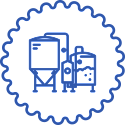
Keywords
Fermentation, Lactobacillus, Brettanomyces, Pediococcus, Turbid, Coolship, Wild, Sours
Description
Propagating a clean strain of Lactobacillus is difficult. This lecture addresses the routes taken to propagate a pitchable quantity of lacto culture, as well as the typical brewing techniques used to achieve a sour beer style. In addition, spontaneous fermentation and the intentional use of wild yeast and bacteria for primary and/or secondary fermentations are discussed. The success resides in cleanliness and strict procedures to avoid infections and cross-contaminations.
Learning Objectives
- Describe the proper techniques in souring beer on the hot side of the brewery
- Appreciate the environmental components leading to a healthy lactobacillus culture, while inhibiting other bacteria
- Understand the need for dextrins in a spontaneous fermentation, and list the steps involved in producing a turbid mash
- Explain the importance of a Coolship, and how it provides the surface to air space ratio necessary for spontaneous fermentation
- Appreciate how the timing of pitching wild organisms can impart different flavors
- Describe the differences between Brettanomyces strains and associated characteristic flavor and aroma profiles
- Explain the role of Pediococcus in wild fermentation and the precautions to take
- Appreciate the importance of a strict cleaning program when producing sour beers

Lecture developed by
Brian Taylor
Brian has over 18 years of experience in the brewing industry. After working with Flying Dog Brewery for three years, in 2003 Brian applied for and was awarded a scholarship to the Siebel Institute. Following completion of the program in 2004, Brian received a Brewing Science Degree at the Siebel Institute and World Brewing Academy in Munich, Germany. Brian began working with wild ales and barrel aging while at Goose Island Beer Company. Award-winning beers such as Sofie, Madame Rose, Juliet and Lolita were created under Brian’s barrel-aging innovation team. In 2016 Brian opened Whiner Beer Company, a brewery dedicated to wild fermentations and sustainability. Using oak barrels and a coolship, Brian creates spontaneously fermented beers.
Read moreEnroll options
Better experience on tablet or higher screen size.
Need guidance? Leave a message and we'll get back to you.